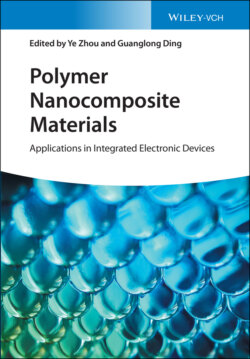Читать книгу Polymer Nanocomposite Materials - Группа авторов - Страница 38
2.3.2.1 Segregated Structure
ОглавлениеThe study about construction of segregated structure was first reported in 1971 [89], and to date much work have been done on this topic [15, 30, 90]. In fact, segregated structure is a unique dispersion state of the conductive fillers in the polymer matrix, at which conductive fillers are dispersed at the interfaces between polymer particles. Mechanical blending and hot compression molding technique is usually applied to fabricate CPCs with a segregated structure [91, 92]. Generally, conductive fillers such as CNTs and graphene were adsorbed to the surface of polymer microspheres by chemical or physical methods, and then the temperature and pressure of hot pressing were controlled, guaranteeing that the conductive fillers were only distributed at the interface between polymer microspheres instead of evenly dispersed in the whole polymer matrix [15, 93, 94].
For example, Wu et al. [95] added amino-functionalized PS microspheres suspension into the GO solution. Graphene was tightly coated on the surface of PS microspheres after a series process of flocculation, filtration, washing, and hydroiodic acid reduction. The composite with a low percolation value of 0.15 vol% was obtained after hot press of the graphene coated PS microsphere. Also, the conductivity of the composite could reach as high as 1024.8 S m−1 when the volume content of graphene is 4.8%, which is much higher than that of PS/graphene and PS/CNT composite made by solvent blending.
An ultralow percolation threshold of 0.047 vol% was achieved by Cui and Zhou [92]. In their work, the conductive PS/graphene and PS/MWCNTs composites with segregated structures were obtained by hot press surface sulfonated PS microspheres and protonated triethylenetetramine functionalized perylene bisimide (HTAPBI)-stabilized nanocarbon. The formation of conductive PS composites with a segregated network is schematically demonstrated in Figure 2.4a. The SEM micrographs of the fracture surface of PS composites containing 0.94 vol% graphene sheets and 0.94 vol% MWCNTs are displayed in Figure 2.4b,c, respectively. Due to the strong electrostatic attraction between the negatively charged PS and positively charged nanocarbon, the interconnected conductive pathways could be preserved regardless of a high hot press temperature, leading to an ultralow percolation threshold.
Figure 2.4 (a) The fabrication process of PS–nanocarbon composite with interconnected networks. Cross-sectional SEM images of PS composites with (b) 0.94 vol% graphene sheets and (c) 0.94 vol% MWCNTs. Source: (a)–(c) Reproduced with permission. [92] Copyright 2017, The Royal Society of Chemistry. Morphologies of double-segregated (d) CNT/PMMA/UHMWPE (0.2/7.8/92.0 by volume) and (e) CNT/PMMA/UHMWPE (0.5/16.2/83.3 by volume) composites. The inset transmission electron micrograph (TEM) image in (e) shows the state of the segregated CNT conductive network in the CNT/PMMA layers. (f) The variation of electrical conductivity for the double segregated CNT/PMMA/UHMWPE composites with different CNT content. Source: (d)–(f) Reproduced with permission. [96] Copyright 2013, The Royal Society of Chemistry.
Pang et al. reported CPCs with double-segregated structure [96, 97]. CNTs wrapped around the small-sized PMMA particles to form the first layer of segregated structure, and CNTs/PMMA were distributed at the interface of the large-sized ultrahigh molecular weight polyethylene (UHMWPE) particles to construct a second layer of segregated conductive network throughout the whole system. The optical micrographs of CNT/PMMA/UHMWPE composite with 0.2 and 0.5 vol% CNTs are shown in Figure 2.4d,e, respectively, showing perfect double-segregated structure. Figure 2.4f shows the electrical conductivity of CNT/PMMA/UHMWPE composites as a function of CNT content. The percolation value of the CPC was calculated to be only 0.09 vol% [96].
Another kind of segregated structure can be constructed by infiltration of flexible elastomers into conductive foams. Carbon based foams (e.g. graphene and CNTs) and carbonized polymer foams are usually selected as the conductive skeleton and polydimethylsiloxane (PDMS) ink was impregnated in the foam to prepare the CPCs [98–100].
